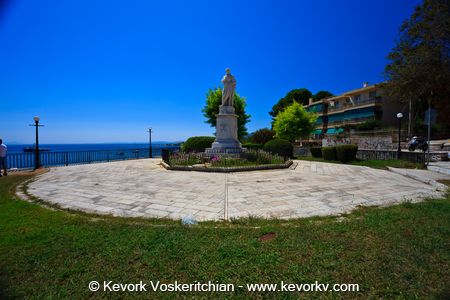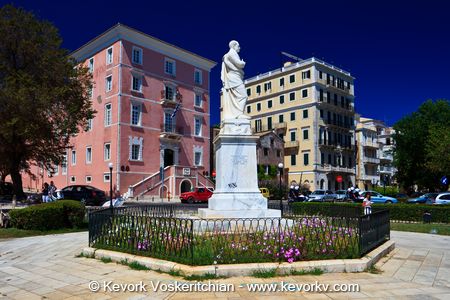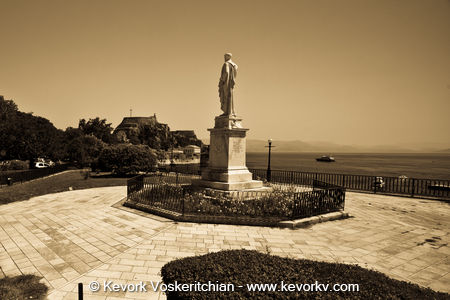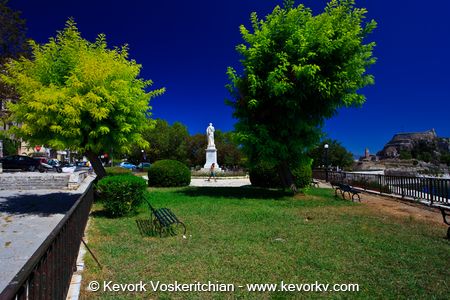

Don't be fooled by the large number of museums on the island, what is preserved to date is a mere fraction of what this island had. A lot was destroyed during the second World war, much of the remaining stolen, beforel their value was realized and protected. Still a lot remains to date to remind us of the significance this tiny island had during the years gone past. The two largest museums, each unique in their own right are the Museum of Asian Arts and the Archeological museum.
Archeological Museum
The Archaeological Museum of Corfu was built between 1962 - 1965. Its initial purpose was to house the archaeological finds from the Temple of Artemis in Corfu. In 1994 it was expanded with the addition of two more exhibit halls that display the more recent finds at the ancient citadel of Corfu. The collection consists of findings from the ancient city of Kerkyra, the Kerkyrian Kassiopi, and also of excavations of Thesprotia. Some of the more impressive works exhibited in the museum, which indicate the island’s prosperity during the ancient period, are the pediment with Gorgon, the tomb of the ancient lion of Menekrates named after the cylindrical cenotaph of Menekrates.

Some works of the archaic period of equal significance are the head of Kouros of the 6th century b.c., which was found in the excavations of Palaeopoli in Mon Repos area, the small statue of Artemis (490 b.c.) which was found at Kanoni, the Kouros (statue of a young man) of Corfu (530 b.c.) from marble and the tomb pillar of Arniada (630-600 b.c.) which was found at the ancient cemetery of Garitsa. Also, in the Museum one can admire the findings of the Palaeolithic period and early Bronze period as well as the newer objects of the Hellenistic and Roman period.
Asian Arts Museum
The Museum of Asian Art is situated in the Palace of Saints Michael and George. It was founded in 1927 and is the only Museum of Asian Art in Greece. In 1919 a collector of Asian art works Grigorios Manos decided to donate his extremely interesting and numerous collection to the Greek State with the presumption that a museum will be created in Corfu in the Palace of the Saints Michael and George. Grigorios Manos donated the first 9.500 art works in 1919 and so became the director of the museum in 1927. Later N. Chatzivasiliou donated 450 art works to the museum in 1974, Ch. Chiotakis donated 341 works from his collection in the beginning of the 1980’s, also the diplomats Giannis Kollas and I. Siniossoglou left their collection to the museum.The museum is dedicated to the arts of Asia, with magnificent collections of Chinese porcelain, Japanese printed pictures, Indian sculptures in bronze and wood carvings. There are well-preserved rooms from the short-lived British rule, with ornate furniture and decorations from that period.

Municipal Art Gallery
Situated within the Palace of St. Michael and George, the Municipal Art Gallery houses a large collection of art works, created by Corfiot painters and artists from the 15th-century Byzantine period.

The Reading Society
The Reading Society of Corfu is the oldest intellectual institution of Greece. It was founded as a “Literary Club” in 1836 during the period of English Protection (1814-1864) by graduates of foreign universities that were sent away from Italy as “karmponari”. The main objective of the “Club” was to establish contacts with political, scientific and intellectual activists of Western Europe. The first president of the Society was an important philosopher, politician, diplomat and professor of the Ionian Academy Petros Brailas - Armenis. The role of the Reading Society proved to be decisive for the history of Corfu and Ionian islands.

The desire of the Society members to establish the free press as well as to impose the Greek language as an official language in the Ionian islands contributed considerably to cultural development of the Ionian islands. The priceless library of the Society consists of 10.000 volumes of bibliography of the Ionian Islands, newspapers, booklets, old maps, engravings and photographs. The Reading Society is a member of the European Federation of Associations and Institutions “Europa Nostra” and was rewarded in 1978 from the Athens Academy for its rich and profound activity. Among the activities of the Society are the organisation of picture galleries of various artists, lectures and seminars, scientific congresses and musical events. The building, where the Reading Society of Corfu is accommodated, represents the work of the architect Ioannis Chronis and is considered to be one of the most characteristic symbols of the city.
Dionysios Solomos
Housing the center of Solomos and Corfiot society studies is the house of the national poet of Greece, Dionysios Solomos where you can see the poet’s desk, a small autograph, manuscripts and other personal items, old photos, maps and portraits of famous Corfiots.

Antivouniotissas Museum
The church is dedicated to the Holy Virgin “Our Lady of Antivouniotissa” (the name “Antivouniotissa” comes from a toponym, indicating the church’s location on the hill called “Antivoúni”) and is functioning from the 15th century. Located in the heart of the historic center of Corfu in the area called Campiello, it represents one of the most characteristic ecclesiastical monuments of the city. It is the oldest, most complete, and best preserved example of the “Heptanesian Basilica” style. After restoration works on the monument, Antivouniotissa now has on permanent display a large and important collection of movable icons and heirlooms.

The collection includes significant works by both well known and anonymous artists, dating from the 15th to the 20th century, which fully represent six centuries of artistic religious expression and creation in Corfu and the Ionian Islands. At some point of time the church was also used as a cemetery where the noble or wealthy Corfiot families maintained family tombs. Antivouniotissa was a private church. In 1979, the Corfiot owner families donated the Avtivouniotissa complex with its rich movable fittings to the Greek public under condition that the church would also function as a museum of Christian art, and that the performance of the Divine Liturgy each December 6, the feast-day of the Virgin Mary to whom it was dedicated, would continue. Antivouniotissa never lost its character as a place of worship, and today holds services twice a year. It is the only such church-museum in Greece, combining in a most harmonious way these two functions within the same monument.
Old Fortress Byzantine Museum
Byzantine collection of Corfu is housed at the 1550 gateway. The guardhouse as you enter has for sale reproductions and other items). The collection includes the mosaics from the basilica of Paleopolis, fragments of frescoes from the church of Aghios Nikolaos in Kato Korakiana village and the sculptures from the old collection from Paleopolis.

Nikolaos Mantzaros Music Museum
First of its kind in Greece the museum honors Nikolaos Mantzaros who composed the Greek National Anthem and the Anthem of the Olympic Games. It portrays the history of the Philharmonic Society founded in 1840, of which Mantzaros was the first director. Exhibits include old musical instruments, photographs, scores and rare early recordings.

Money Museum

Serbian Museum
This resulted in the abandonment of the Serbs with their government of their homeland and the finding of shelter in the island of Corfu. The “Island of Salvation”, as it was named by the Serbs, the Serbian army and its citizens reached after many hardships and distress that they faced in their travel via Montenegro and Albania. Unfortunately, the residents of the island were not suitably prepared to accept the Serbs which resulted in having insufficient amount of supplies. The food, the thermal means and the more general equipment that was given to the Serbs were not enough to avoid the continuation of the mass deaths of the Serbian population and army from the hunger and the bitter frost of the winter of 1916. Later with the help of the mild climate and the acquisition of suitable equipment and new clothing the Serbian army survived the distress and recovered completely. The relations of the Serbs with the locals became very close in the three-years that they stayed in the island. The Corfu people granted them the Municipal Theatre for the meetings of the Serbian Parliament, a hotel for the accommodation of the Serbian government as well as the churches of Archangelo Gabriel, Saint Trinity and Saint Nikolaos Gerondon, for their religious needs. Also, Serbian shops, Serbian schools, athletic associations were created while the concession of a printing-house was allowed to the Serbs for the publication of their own newspaper.
The “Serbian Hearth” or the “Serbian House” is the building where the Consulate of Federal Republic of Serbia and the Museum of “the Serbs in Corfu 1916-1918” are accommodated. In the Museum there are various objects from the Serbs of the A' World war like photographs, maps, documents, uniforms, arms and equipment, flags, medical tools, and ecclesiastical vestments that indicate the Serbian presence in the island during that period while at the same time reveal historical data of the Serbian population at the duration of the A' World War. In the A' World War the Austro-Hungarian, German and Bulgarian army accomplished to prevail the Serbian army in the Serbian front.
Ceramics Folklore Arts
Located at the English Barracks, in the New Fortress It includes various ceramic objects of everyday use, as well as folklore items from
Paleopolis (Mon Repo)
Archaeological findings from the excavations in Paleopolis area covering the period from Archaic to Roman years. Exhibits include objects from the 19th century, related to the use of the palace, as well as photo exhibition from the excavation procedure

Kapodistrias Museum
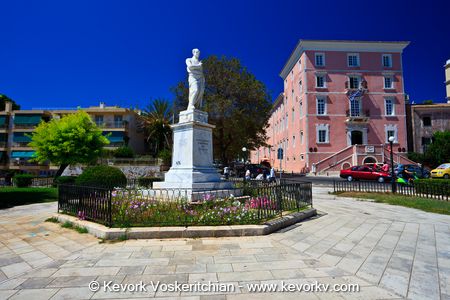
The Kapodistrias Museum or Kapodistrias Museum-Centre of Kapodistrian Studies is a museum dedicated to the memory and life s work of Ioannia Kapodistrias. The property was donated by Maria Desylla-Kapodistria great granddaughter of Georgios Kapodistrias, younger brother of Ioannis Kapodistrias. The museum was established in 1981. Ioannis Kapodistrias summer home in the rural area of Koukouritsa in his birthplace of Corfu, houses the museum, showcasing exhibits commemorating his life and accomplishments. Mrs Maria Desylla-Kapodistria, a former Corfu mayor from 1956-1959 and the first female mayor of Greece, donated the residence to the three primary cultural societies of Corfu specifically for that purpose. The museum also functions as a centre for Kapodistrian and Corfiote studies.
In 1979 Maria Kapodistria bequeathed the estate under contract No. 4541/3.11.1979 to the Reading Society of Corfu, the Philharmonic Society of Corfu and the Society of Corfiote Studies. According to its charter, the museum is to house, curate and exhibit the personal effects and portraits of Ioannis Kapodistrias as well as the period furniture belonging to the family. Following the death of the donor the three societies created a foundation under the name "Kapodistrias Museum-Centre of Kapodistrian Studies".The Kapodistrias residence is located in the southwest corner of an area near the village of Evropouli nine kilometres from Corfu city. The area is called Koukouritsa meaning a hill in the local dialect and denoting the top of the hill. The hill and the surrounding area belonged to the Kapodistrias family for centuries.In the middle of the 18th century a small summer cottage was built to serve as a summer retreat for the Kapodistrias family. In 1797 after the end of the Venetian occupation, Ioannis Kapodistrias father, Antonios Maria Kapodistrias, representing the more conservative side of Corfu aristocracy quickly came to a dispute with the French occupiers and had to escape to the summer cottage at Koukouritsa. The family resided there until the early 19th century. Young Ioannis Kapodistrias followed his family to the retreat and stayed there for approximately three years.
The three Corfu societies accepted the estate along with the exhibits but Maria Kapodistria did not provide an ongoing financial endowment. The Greek state and even the municipality of Corfu largely ignored the project. Nevertheless the three societies founded the Museum as a civil liability company. The three societies, however, did not have the finances to continue the day-to-day operations of the museum and soon they were forced to close it for an extended period of time.The subject of the museum s closing and the indifferent reaction of the Greek government was actually raised by opposition leader George Papandreou in 2005 who characterised the museum as an important monument for Greece.The three societies applied to the Greek Ministry of Culture, other state organisations as well as to various municipal governments in Corfu, but were ignored. However Christos Fokas, a local businessman residing in Switzerland, owner of the Corfu Palace Hotel, informed the three societies that he was ready to cover the museum s operating expenses donating the sum of 20,000 euro per year. The donation enabled the Museum to open once again to the public and it operates on a daily basis from 10:30 a.m. to 2 p.m. It is closed on Mondays.
National Gallery Annex of Corfu

Click here to view the museums web site



© 2016 All CopyRights Reserved
All content is copyrighted, no part my be copied, or used, for any reason, without the prior written agreement.
Any and all copyright violation will be legally prosecuted.
Museums
























